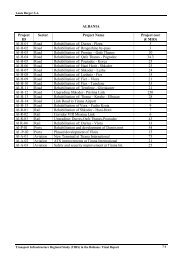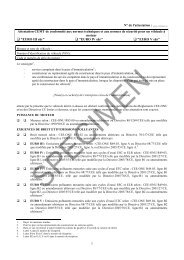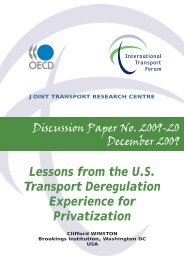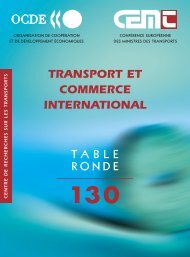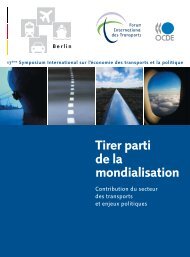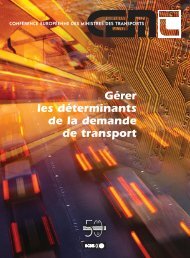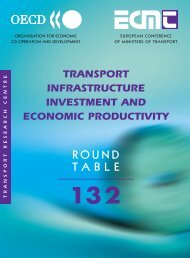Understanding the Value of Transport Infrastructure ...
Understanding the Value of Transport Infrastructure ...
Understanding the Value of Transport Infrastructure ...
Create successful ePaper yourself
Turn your PDF publications into a flip-book with our unique Google optimized e-Paper software.
UNDERSTANDING THE VALUE OF TRANSPORT INFRASTRUCTURE<br />
c. They are immovable; and<br />
d. They may be subject to constraints on disposal.<br />
Although ownership <strong>of</strong> infrastructure assets is not confined to entities in <strong>the</strong> public<br />
sector, significant infrastructure assets are frequently found in <strong>the</strong> public sector.<br />
<strong>Infrastructure</strong> assets meet <strong>the</strong> definition <strong>of</strong> property, plant and equipment and should be<br />
accounted for in accordance with this Standard. Examples <strong>of</strong> infrastructure assets include<br />
road networks, sewer systems, water and power supply systems and communication<br />
networks”.<br />
Fur<strong>the</strong>rmore, also <strong>the</strong> issue <strong>of</strong> maintenance is addressed in IPSAS 17. In para. 23, it is<br />
stated that “… an entity does not recognize in <strong>the</strong> carrying amount (<strong>the</strong> amount at which<br />
an asset is recognized, addition PvdV) <strong>of</strong> an item <strong>of</strong> property, plant and equipment <strong>the</strong><br />
costs <strong>of</strong> <strong>the</strong> day-to-day servicing <strong>of</strong> <strong>the</strong> item”. On <strong>the</strong> o<strong>the</strong>r hand, para. 24 states that<br />
<strong>the</strong> replacement <strong>of</strong> parts at regular intervals, for example a road that needs resurfacing<br />
every few years, should be recognized according to <strong>the</strong> criteria in para. 14 (see above).<br />
It also states that <strong>the</strong> carrying amount <strong>of</strong> those parts that are replaced should be<br />
derecognized.<br />
Disregarding textual differences, and a consequence differences in interpretations, one<br />
can say that <strong>the</strong> 2008 SNA and IPSAS use <strong>the</strong> same kind <strong>of</strong> concept for defining<br />
investments in general and transport infrastructure in particular.<br />
IPSAS does not seem to include specific rules in relation to <strong>the</strong> time <strong>of</strong> recording <strong>of</strong> large<br />
infrastructural investments, <strong>the</strong> production <strong>of</strong> which involves several years and payments<br />
are done in stages. On <strong>the</strong> o<strong>the</strong>r hand, <strong>the</strong>re are quite specific standards for <strong>the</strong><br />
valuation <strong>of</strong> <strong>the</strong> costs <strong>of</strong> investment:<br />
“The cost <strong>of</strong> an item <strong>of</strong> property, plant and equipment comprises:<br />
a. Its purchase price, including import duties and non-refundable purchase taxes,<br />
after deducting trade discounts and rebates.<br />
b. Any costs directly attributable to bringing <strong>the</strong> asset to <strong>the</strong> location and condition<br />
necessary for it to be capable <strong>of</strong> operating in <strong>the</strong> manner intended by<br />
management.<br />
c. The initial estimate <strong>of</strong> <strong>the</strong> costs <strong>of</strong> dismantling and removing <strong>the</strong> item and<br />
restoring <strong>the</strong> site on which it is located, <strong>the</strong> obligation for which an entity incurs<br />
ei<strong>the</strong>r when <strong>the</strong> item is acquired or as a consequence <strong>of</strong> having used <strong>the</strong> item<br />
during a particular period for purposes o<strong>the</strong>r than to produce inventories during<br />
that period” (IPSAS 17, para. 30).<br />
“Examples <strong>of</strong> directly attributable costs (which are not part <strong>of</strong> <strong>the</strong> investment costs,<br />
PvdV) are:<br />
a. Costs <strong>of</strong> employee benefits (as defined in <strong>the</strong> relevant international or national<br />
accounting standard dealing with employee benefits) arising directly from <strong>the</strong><br />
construction or acquisition <strong>of</strong> <strong>the</strong> item <strong>of</strong> property, plant and equipment;<br />
b. Costs <strong>of</strong> site preparation;<br />
© OECD/ITF 2013 41





